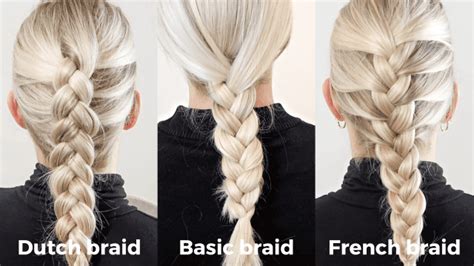Introduction: The Battle of the Braids
Braids have been a versatile and captivating hair accessory for centuries, gracing heads from royalty to rebels alike. Amidst the myriad of braiding techniques, two stand out as iconic: the French braid and the Dutch braid. Each possessing its unique charm and advantages, these braids have captured the hearts of hair enthusiasts worldwide. Join us as we delve into an in-depth comparison of the French vs. Dutch braid, exploring their intricacies, similarities, and differences.

French Braid: The Intricate Classic
The French braid, also known as the “plait,” originated centuries ago in French countryside. Elegantly crafted by sectioning, crossing, and interweaving strands, this braid creates a raised, three-dimensional effect.
Appearance and Technique
- Raised and voluminous appearance
- Tightly woven strands create a clean and polished look
- Braided from the back to the front, with the hair divided into three even sections
- Strands are crossed over each other repeatedly, adding depth and texture
Dutch Braid: The Upside-Down Delight
The Dutch braid, also known as the “inside-out” or “reverse” French braid, is a captivating twist on the classic French braid. This technique inverts the braiding motion, resulting in a unique and eye-catching look.
Appearance and Technique
- Lowered and inverted appearance, with strands woven underneath instead of over
- Creates a bolder and more distinctive texture than the French braid
- Braided from the back to the front, but with the hair divided into three even sections
- Strands are crossed under each other repeatedly, forming a more compact and intricate braid
Commonalities and Differences: A Comparative Analysis
While the French and Dutch braids share some similarities, they possess distinct characteristics that set them apart.
Similarities
- Both are three-strand braids that originate in France
- Both involve sectioning the hair and crossing the strands over or under each other
- Both can be worn in a variety of hairstyles, from buns to ponytails
Differences
| Feature | French Braid | Dutch Braid |
|---|---|---|
| Appearance | Raised and voluminous | Lowered and inverted |
| Texture | Clean and polished | Bolder and more intricate |
| Creation | Strands crossed over | Strands crossed under |
| Weaving Technique | Adds depth and texture | Creates a compact and intricate effect |
Pros and Cons: Which Braid Reigns Supreme?
The choice between the French and Dutch braid ultimately depends on personal preference and the desired look. However, each braid has its own advantages and disadvantages to consider.
French Braid
Pros:
- Classic and elegant appearance
- Versatile and suitable for various hair types
- Less bulky and easier to sleep in
Cons:
- Can be time-consuming to create
- May require practice to achieve a clean finish
- Can appear flatter on fine or thin hair
Dutch Braid
Pros:
- Bold and unique appearance
- Adds volume and depth to fine or thin hair
- More secure and less likely to come undone
Cons:
- Can be more bulky and uncomfortable to sleep in
- Requires more skill and precision to create
- May appear too heavy or overpowering on thick or curly hair
Tips and Tricks: Mastering the Art of Braiding
Whether you’re a seasoned braiding expert or a novice enthusiast, perfecting the French or Dutch braid requires a few key tips and tricks.
For the French Braid:
- Divide the hair into even sections and secure the top section with a small elastic band to prevent it from slipping out
- Practice crossing the strands over each other swiftly and smoothly
- Slightly tug on the strands as you braid to tighten the braid and create a more raised effect
For the Dutch Braid:
- Follow the same steps as the French braid, but invert the crossing motion and cross the strands under each other
- Pay attention to the tension of the braid, as it should be slightly tighter than the French braid
- Use a boar bristle brush to smooth out any flyaways and enhance the shine
Innovative Applications: Unleashing Creativity
Beyond the traditional uses, French and Dutch braids offer a plethora of creative applications.
- Intricate Headbands: Braid sections of hair and pin them together to form a stylish headband
- Embellished Updos: Incorporate braids into updos for a touch of elegance and texture
- Side-Swept Braids: Sweep a French or Dutch braid to the side for a flattering and asymmetrical look
- Braided Pigtails: Create playful and youthful pigtails by braiding two sections of hair on either side of the head
- Intricate Crowns: Weave a French or Dutch braid around the head to create a stunning and eye-catching crown
Conclusion: The Verdict
In the battle of the braids, both the French and Dutch braid emerge as victors, each possessing its unique charm and advantages. While the French braid reigns supreme for its classic elegance and versatility, the Dutch braid steals the spotlight with its bold and eye-catching texture. Ultimately, the choice between these two braiding giants depends on personal preference and the desired look. Embrace the artistry of braiding and let your creativity soar, as these versatile techniques continue to inspire and captivate hair enthusiasts worldwide.
